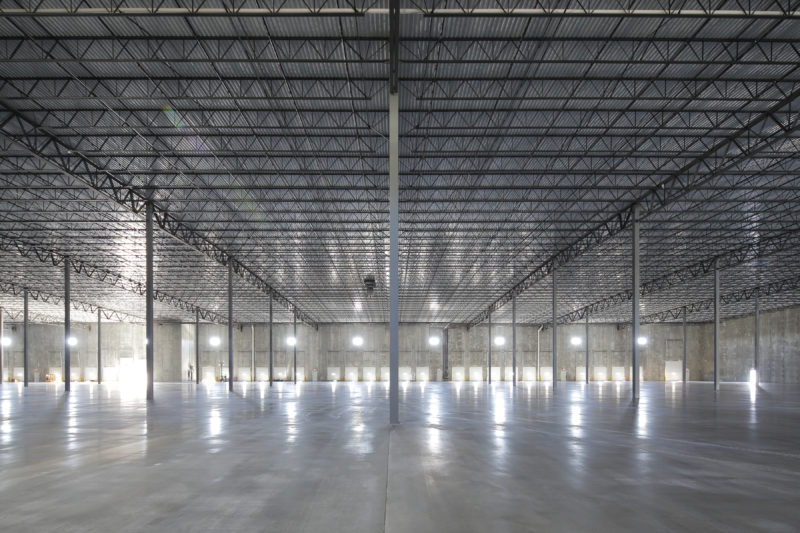After developing 750 Union Ave., a 263,415-square-foot distribution center in Union, Bridge Development Partners sold the property late last year for $46.5 million — more than $176 per square foot. — Courtesy: Bridge Development Partners
By Joshua Burd
It was a year ago when Bridge Development Partners inked its first lease at 750 Union Ave. in Union, where it had torn down an obsolete building and replaced it with more than 260,000 square feet of modern industrial space just seven miles from Port Newark-Elizabeth.
Within just a few months, the developer found out just how much value it had created.
Not long after the firm signed the 144,000-square-foot lease with Boxed.com, a mobile delivery service for wholesale goods, capital markets brokers with CBRE called and proposed bringing the property to the investment community. Fast-forward to last December, when a fund managed by J.P. Morgan acquired the property for $46.5 million — more than $176 per square foot.

It was an eye-catching number for industrial property. And to Jeff Milanaik, principal with Bridge, that made it clear just “how much more value we realized in the project because of the strong appetite by institutional investors” and based on the rise in rental rates.
“We certainly realized better value than we thought, just because of what had occurred in the market,” said Milanaik, who lightheartedly cited another important factor: “A lot of this is market timing, which I’m a glad recipient of, but I take zero credit for.”
The deal was the latest example of a new reality in New Jersey’s commercial real estate industry: Warehouse and distribution space in the state has become a prized asset class among institutions and other major investors, leading to increased competition, surging prices and more creativity by those looking to add industrial to their portfolio.
RELATED: A look at recent investment sales in New Jersey’s industrial market
As insiders note, there is nothing sexy about warehouse space. But it’s a business that has long been associated with strong occupancy levels and some degree of predictability. And the rise of e-commerce and other sectors that depend on being close to population centers has ushered in a new era for the owners of logistics real estate.
“It’s a very stable asset class that’s now experiencing rent growth,” said Robert Kossar, executive managing director with JLL and head of the firm’s New Jersey office. He pointed to fundamentals that are overwhelmingly positive: Demand is “unprecedented,” with around 50 percent of it coming from e-commerce tenants or related industries, all of them feeding off of a titanic shift in consumer behavior and the scramble for so-called last-mile locations.

On the other hand, supply is increasingly limited in northern and central New Jersey, where overall vacancy is 4 percent, according to JLL. Developable sites have become few and far between, and those that do exist often come with environmental challenges or other hurdles. Speculative projects are consistently being preleased or leased shortly after completion, and average asking rents have risen to about $7 per square foot, up from $5.50 in 2015.
In submarkets such as northern Bergen County, new buildings have commanded rents upwards of $8 and $9 per square foot.
The formula has made it easier for pension funds, sovereign wealth funds and other sources of institutional capital to underwrite deals at today’s pricing for industrial property, which is decidedly lower-maintenance and easier to grasp than other asset classes. Kossar said that institutional players “have not only taken a larger sliver in real estate, but they’ve increased their allocation in industrial,” recognizing the perfect storm of fundamentals and rent growth.
Industrial has become even more appealing to heavyweight investors who have jockeyed for apartment properties in recent years.
“A lot of the big institutional funds have loaded up on multifamily since 2010,” said Jose Cruz, an investment sales broker and senior managing director with HFF. “And I think now they’re looking at how they can diversify some of those portfolios to the extent that they want to, and industrial has become one where they’re underweighted.”

The challenge, Cruz said, “is getting enough to make a difference in one of their institutional funds, because the deal sizes sometimes aren’t as large” for industrial as they are in multifamily or office deals.
Through late June, the industrial sector had accounted for about $914 million worth of northern New Jersey’s investment sales activity in 2017, according to the research firm Real Capital Analytics. That represents an uptick of only about 8 percent from the same period last year, but industrial space has become increasingly valuable to investors: The average price per square foot in such transactions climbed to $88 in the first quarter of 2017 from $64 at the start of 2013.
By comparison, industrial sales for the U.S. averaged $79 per square foot in Q1, Real Capital Analytics found.
Brokers also note that, while dollar volume is increasing in New Jersey, that doesn’t necessarily mean that more properties are changing hands. Brian Schulz, managing director with Newmark Knight Frank, said the number of opportunities has actually decreased in recent years.
“When you look historically at activity, it’s actually been inching down year by year … largely because there are very few sellers out there,” Schulz said. “People are viewing the New Jersey industrial market as core to their portfolio and not wanting to release any of those holdings.”

He pointed to the scarcity of what are known as core opportunities — essentially, newer buildings with higher ceilings in submarkets along the New Jersey Turnpike.
Through early June, the only such property to change hands in 2017 was 350 Starke Road in Carlstadt, a 353,349-square-foot complex that sold for $73 million. The price paid by Bentall Kennedy, a Toronto-based manager for institutional clients, equates to about $207 per square foot.
The stiffer competition and the search for yield in New Jersey has caused some investors to look at options that they haven’t in past cycles, such as buying older buildings that lack modern features but are still in core markets along the New Jersey Turnpike.
In other cases, investors are going after buildings in secondary locations, such as the corridors along interstates 287 and 80.
Earlier this year, Prologis Inc. sold a 366,896-square-foot building at 13 Jensen Drive in Somerset to Cabot Properties, a Boston-based fund manager. Located off I-287, about 14 miles from the Turnpike, the property commanded a price of $44.6 million or $121.56 per square foot.
“It’s a very good, modern-generation building, but that’s typically outside of the purview of industrial and institutional investors,” Schulz said. “So you’re starting to see investors play in that kind of space.”
For those who are willing to sell, tapping into that demand can come down to assembling a package that institutional investors are looking for. The Hampshire Cos. did exactly that this past spring when it sold a six-building, 1.2 million-square-foot portfolio for $147 million. The offering, marketed by HFF, included properties in Middlesex, Bergen and Essex counties, all concentrated around the Turnpike or I-80.

“There’s so much capital looking for deals, but they also want scale and it’s hard for them to deploy their capital one building at a time,” said Todd Anderson, principal and executive vice president with Hampshire, which is based in Morristown. “It’s very inefficient. They need to deploy and they want to be north of $100 million or north of even $150 million just to be able to acquire the scale that they need to get into the marketplace.”
The buyer, AEW Capital Management, walked away with a 96 percent leased portfolio that brokers say offered potential rental upside in strategic locations.
RELATED: Hampshire sells six-building industrial portfolio for $147 million
Other institutions have different strategies for putting their capital to work. Some are increasingly going after so-called build-to-core opportunities, in which they develop a new property in a top-tier market. Kossar, the JLL executive, said that institutions historically have preferred existing, leased buildings that could offer immediate cash flow, “but because there are so few deals to be had, those investors have allocated a certain portion of their core funds to include development in a build-to-core mentality.”
That activity includes an increase in forward sales, in which a buyer agrees to acquire the property before it is built, while often providing a down payment to the developer.
“There is definitely a demand for those forward deals,” said Cruz, the HFF broker. “And they’re pricing aggressively — investors, especially the institutions, are willing to take the lease-up risk, which is something also fairly unique in the market today.”
Institutional investors are also partnering with local New Jersey developers.
“And it makes a lot of sense because we’ve got an undersupply of Class A buildings, we have a low vacancy rate and we’ve got more tenants in the market than we have space to fill all of the demand,” Kossar said. “It’s a great way for them to get capital out and end up with Class A, new product at yields that will be slightly better than if they were able to buy an existing building.”
Rent growth in the state’s industrial market has gone hand in hand with the expansion of the tenant base in New Jersey. Schulz noted that e-commerce companies are growing the market without displacing those that have historically occupied space here.
“It’s not as if the New Jersey occupiers are leaving,” he said. “It’s true organic growth to the market.”

That has been especially pronounced around Exit 8A and Exit 7A of the Turnpike, he said. Because the submarkets relied in the past on third-party logistics firms, whose business is typically contract-based, they were among the hardest hit when the economy slowed. But 8A and 7A are now anchored by the likes of Amazon and Wayfair, which come with long-term commitments and a need to maintain their presence in the population center.
That has led to unprecedented rent growth in markets such as 8A, where some top-flight buildings command more than $6 per square foot. It all translates into a growing appetite from investors, who are now considerably less concerned about the highs and lows of those markets.
Owners and brokers note that some e-commerce users are relatively new businesses. As such, landlords may find themselves considering a tenant that has a limited credit history or one that is in the middle of raising capital.
Milanaik, the Bridge Development principal, said you simply “have to take it one at a time.”
“There is an inherent risk … and we try to rationalize the specifics of the business model,” he said. “From our perspective, is it a flash in the pan or is it sustainable based on the flow of goods?”

Those considerations could ultimately become front and center for investors, but insiders say institutions thus far have been bullish on e-commerce properties if everything checks out.
Across the industrial sector, Kossar said “all of the fundamentals point to continued rent growth,” although he believes it will be at a more measured pace. There is sustained demand from tenants and the barriers to entry for new development continue to be high.
RELATED: New lease structures, longer terms take hold in N.J. industrial market
Schulz is equally bullish about the continued demand from investors.
“I think, speaking specifically in industrial, there has been very little trepidation,” he said. “If anything, it’s more anxiety about not being able to get in on the party.
“People are anxious to be part of one of the fastest-growing and most exciting industrial markets in the country. And you’re hearing all of these sound bites from investors, from developers, from leasing brokers about how the New Jersey industrial market is poised for continued growth. The biggest problem right now is there’s not enough space.”










